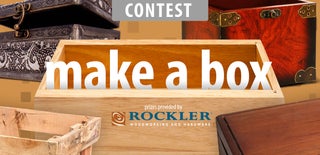Introduction: Diy Standing Jewelry Case W/ Mirror Door
Obviously, I decided I could make it better for less. In fact, the entire build is made from recycled lumber and small scraps I had in the garage.
Step 1: Gather Materials
If you take a look at one of my other Instructables you’ll see how i like to cannibalize trash for supplies. A lovely 1970’s kitchen cabinet gave it’s plywood to aid in the construction of this project.
All in all I used:
1/2“ plywood from cabinets
¾” plywood my neighbor used to cover a cement patch job in our alley
47” mirror from IKEA ($10)
2x4 Lumber
2 x 3” Bolts, 4 washers, 2 lock nuts
An assortment of hooks
Paint & Primer of your choosing
Step 2: Build a Frame
First you'll want to build a frame. I used ½” plywood for the body. The strips I used are 4" deep but feel free to use my measurements as a loose guideline. You may choose a thinner setup to take up less space or a deeper arrangement for more storage.
Because them mirror I'm going to use is about 47” I'm building the frame just a bit larger. If you have a larger piece of plywood I'd recommend making the side panels with a single piece for increased tensile strength.
I am piecing together scraps so I used a small square to join the larger planks. Make the top plank shorter. You want this piece of furniture to be bottom heavy so the mirror hangs right.
I recessed the joining square a half inch so that I could recess the plywood backing into the cabinet. You'll see that later.
Step 3: Put Some Backing in the Frame
The backing is where items in your cabinet will hang or settle.
I cut the backing to the same lengths as the side boards. As you can see in the pictures, the backing board is recessed into the frame. I used the joining square as an initial nailing point. I used an 18 gauge finish nailer for this portion. I then shot about 30 nails around the perimeter of the frame into the backing.
Once I got the backing installed the cabinet was starting to take shape and the frame was much more rigid than it had been previously.
Step 4: Build Some Legs
Your cabinet is going to need at least a simple base to rest on.
I did this part with 2x4 lumber. To be honest, it was closer to 2x3. Make each leg just a bit taller than where your joining square seem is. This is where you will drill and connect the stand to the cabinet.
I joined the legs to each other with a board near the bottom for a little more stability. Then I added a 15" "foot" piece to each leg to complete the standing setup
Finally, Drill a hole near the top of each leg and then through the frame on each side into the joining square. (The extra thickness is ideal for the bolt's placement) Put your bolt through the leg, into the frame, and tighten it!
Step 5: Add the Mirror
I put the door on the cabinet with some hinges I salvaged from a neighbor's trashed tv stand.
Putting a mirror on this piece of furniture might seem intimidating because of the fragility of the glass but it was fairly simple. This mirror came with a clip setup which made installation fairly simple. If you don't have clips you could get some silicon caulk. They use it for installing mirrors in bathrooms so I'm confident it would hold the mirror on the cabinet in your bedroom without any concerns.
Step 6: Put Some Hooks in There!
You're going to need a few hooks if your lady wants to actually hang something in this. This is really easy to do. I found a 100 pack at a local discount store for $.99. All I had to do was drill a few pilot holes and twist the hooks into place.
Now she's ready to use.
(Mind you, I've only added a few hooks in this picture)
Step 7: Finishing
The finish is up to the builder. Ideally, you'll prime any raw wood before you paint it. I use a dark grey primer whenever I'm going to paint a lighter color. It makes it clear that I've completely covered the piece in paint and the lighter colors appear more brilliant over a dark color.
Note: The space at the top of the door is intentional. I'm planning to design and build a decorative valance to finish the design off.
Step 8: Conclusion
There you have it.
This end product was definitely MUCH stronger than the in-store equivalent and I spent less than $20 on everything.
If you like this project I encourage you to try it out for yourself and post a picture in the comments. I'll be sure to post a few more pictures when I finalize the paint!
Thanks for checking out my project!!!

Participated in the
Make a Box Contest











